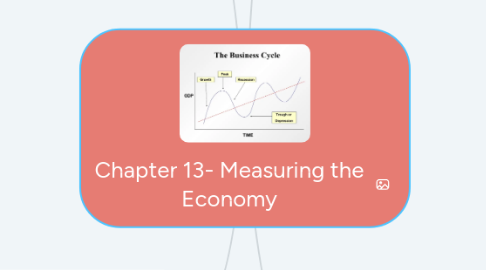
1. 13.4- What Does the Inflation Rate Reveal About an Economy’s Health?
1.1. When the inflation rate rises, it is tracked by the Bureau of Labor Statistics and added to the cost of living
1.1.1. Cost Of Living index- a measure of change in the overall cost of goods and services; another term for the consumer price index
1.2. The real cost of living is not measured in money but in the time we must work to live
1.3. Creeping Inflation, Hyperinflation, and Deflation are all terms said that can slightly or majorly effect the economy
1.3.1. Deflationary Spiral- a downward trend in prices, wages, and business activity
1.4. There are large economic costs of inflation including loss of purchasing power, higher interest rates, and loss of economic efficiency
2. 13.5- How Does the Business Cycle Relate to Economic Health?
2.1. The business cycle consists of four phases that are expansion, peak, contraction, and trough
2.1.1. Business Cycle- a recurring pattern of growth and decline in economic activity over time
2.2. Some economic indicators include leading indicators, coincident indicators, and lagging indicators
2.3. A boom is the expansion phase of the cycle, known as an upturn, or period of prosperity but it leads to a bust or downturn of the business cycle, is also called a recession
2.3.1. Depression- a prolonged economic downturn characterized by plunging real GDP and extremely high unemployment
2.4. As business inventories shrink over time, firms begin to increase production. Hiring begins to pick up. economic confidence returns and consumers start spending again
3. 13.2- How Do Economists Measure the Size of an Economy?
3.1. By measuring its gross domestic product. GDP is an economic indicator that measures a country's total economic output
3.1.1. GDP- the market value of all final goods and services produced within a country during a given period of time
3.2. The economy is divided into four sectors: households, businesses, government, and foreign trade
3.2.1. Net Exports- the value of all exports minus all imports
3.3. A few limitations with measuring with GDP include ignoring illegal trade and negative externalities, as well as leaving out unpaid house and volunteer work
3.4. It does help in ways such as increasing literacy rate, overall health, and standard of living
4. 13.3- What Does the Unemployment Rate Tell Us About an Economy’s Health?
4.1. High unemployment is seen as having an economy that is poor while low is good but also has its disadvantages
4.2. Unemployment rate can be found by taking the amount of people currently not having a job but looking for one, divided by the amount of people in the labor force
4.3. There are four main types of unemployment: frictional, structural, seasonal, and cyclical
4.3.1. Frictional- a type of unemployment that happens when workers are seeking their first job or have left one job and are seeking another
4.3.2. Structural- a type of unemployment that results because of changes in technology or the demand for certain jobs declines
4.3.3. Seasonal- a type of unemployment that results when businesses shut down or slow down for part of the year
4.3.4. Cyclical- a type of unemployment that results from decline in the business cycle

